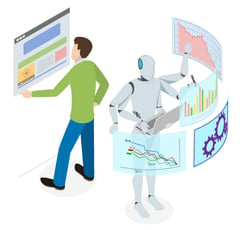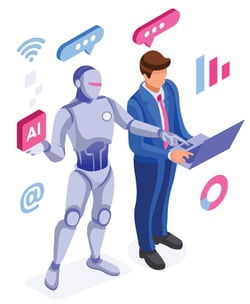 Innovation in technology and product development is the key driver of progress in today's fast-paced world. It involves creating and implementing new ideas, processes, and products to improve efficiency, solve problems, and meet the evolving needs of society. From artificial intelligence (AI) and renewable energy to smart devices and biotechnology, product development innovation impacts nearly every aspect of our lives.
Innovation in technology and product development is the key driver of progress in today's fast-paced world. It involves creating and implementing new ideas, processes, and products to improve efficiency, solve problems, and meet the evolving needs of society. From artificial intelligence (AI) and renewable energy to smart devices and biotechnology, product development innovation impacts nearly every aspect of our lives.
The future holds exciting possibilities as innovation expands the limits of so many industries. These advancements utilize cyber-physical products combining hardware, software, and sensing technology. When several of these products interact to create intelligent, interconnected systems, they're called cyber-physical systems (CPS). These systems make it possible for machines to interact with their physical surroundings and move or operate with precision.
Industries that Use Cyber Physical Systems
Smart cyber physical systems are well-suited for industries such as manufacturing, health care, agriculture, and automotive due to their ability to function with autonomy, functionality, safety, and reliability.
Manufacturing
The factory floor is one location where cyber physical systems have been well-established for some years already. Building on the Internet of Things (IoT), large-scale cyber-physical systems can automate manufacturing processes to optimize processes, increase safety, and reduce costs on labor and materials.
Healthcare
The use of cyber-physical systems in the healthcare field is typically in the form of medical devices. Doctors can use these smart devices to track their patients' status and physical condition, whether in the clinic or hospital or in the comfort of their homes. This ability also lets healthcare professionals monitor a patient's health in a non-intrusive, convenient manner.
Cyber physical systems are also used in home safety designs. For example, patients who want to age in place rather than move to a designated medical facility can benefit from systems in their own homes. Smart sensors can be placed in the home to detect an accident or fall and alert an emergency response system to help. This system brings peace of mind and convenience to both the patient and their families.
Agriculture
Innovative cyber-physical systems in agriculture are poised to revolutionize the industry. From autonomous machines that pick weeds while preserving crops to selective pesticide application systems to systems that support agriculture management, these systems are making farming more efficient. The ability of machines to study, collect samples, and analyze information about the climate, soil, water, and plants could play a major part in improving how we farm.
Autonomous Vehicles
An industry that has rapidly improved its integration of cyber-physical systems is the automotive and aerospace industries. Cars, trucks, and airplanes are vehicles that have integrated computers and software into their physical platforms to offer futuristic abilities from park-assist to navigation to autonomous driving. While vehicles aren't ready to drive themselves completely, the technology is getting close, we just need the infrastructure to keep up.
Green Energy Systems
Communities can use cyber-physical systems with smart electric grids to offer advanced control of the infrastructure. In the case of electricity generated by wind farms, cyber-physical systems can monitor and adjust the current flow in the grid to accommodate the power generated by the wind farm. The system can then adjust the current flow when the supply adjusts to normal levels, keeping the system and users safe.
Further Benefits of Cyber-Physical Products and Cyber-Physical Systems
 In addition to concrete examples of innovation using cyber-physical products, there is immense potential for new discoveries and product development.
In addition to concrete examples of innovation using cyber-physical products, there is immense potential for new discoveries and product development.
Smart Cities and Infrastructure
Just as individuals are converting their houses into smart homes with intelligent appliances, HVAC systems, electrical systems, and more, there is the potential to transform entire communities into smart cities. With cyber-physical systems that span commercial buildings to office buildings to the electrical grid and infrastructure, full cities can become more efficient and sustainable when set up strategically.
Imagine a public transportation system that is not only safe but also always running when the demand is the highest and travels with greater efficiency, so you're never late for your appointments. Imagine power grids that optimize resource usage to increase sustainability and reliable power delivery. Scaling these systems to accommodate community-wide projects is not far on the horizon.
Enhanced User Experiences
With cyber-physical technology, monitoring and gathering real-time feedback on how customers interact with a product has become easier than ever. It's also been a game changer when it comes to offering an enhanced user experience. Product teams can solicit direct feedback from the end-user, but they can also watch how the product is used and find ways to add value that the customer may not even realize or think about.
Advanced sensors can also trigger added value in real time. For example, surveillance cameras in warehouses that can detect heat spots before a fire breaks out can alert a response system to address the heat and prevent serious damage. Another example of real-time value is sensors in home appliances that track, monitor, and remember your patterns to adjust light and heat settings based on when you're home and the external temperature.
Such innovation and advancements in our environments mean we won't have to ask Alexa to do anything; the system will automatically take care of it for us.
Cross-Industry Collaboration
One example of a benefit of cyber-physical product development that doesn't involve the customer is the required collaboration between industries. Integrated machines and computer systems encourage various industries to collaborate on new products, making advancements that could not be made when working alone. These interdisciplinary approaches lead to leaps in innovation because different sectors are leveraging each other's expertise and technology.
Innovation in Education and Research
While cross-collaboration in cyber-physical product development is leading to greater discoveries, it's also fostering innovation in education and research. Instructors can enhance the learning experience by providing interactive and immersive learning opportunities. Between virtual labs, simulation environments, and smart educational tools, the classroom is rapidly changing.
Addressing Challenges in Developing Cyber-Physical Products
Designing and developing any product can follow different frameworks and methodologies, depending on the complexity of that product. The components of a cyber-physical product will vary from hardware to complex and delicate parts like sensors to digital software programs. The challenge is to manage these diverse parts and ensure the entire product team stays aligned and in sync with each other.
Some of the product development challenges that cyber physical products generate may include:
- Staying agile in the product development process
- Adapting to the quick demand for changes or upgrades
- Being responsive to data collected
- Prioritizing information and ideas
- Aligning to the cadence of each team's milestones
Agile development teams can make their product management work effectively with the right tools and communication strategy in place.
Product Roadmapping Software that Supports Innovation
At Gocious, we applaud innovation and fresh thinking in the product world. Our product roadmap management software is constantly evolving to better serve the needs of product management teams. Book your free demo to see how Gocious helps align your teams.


